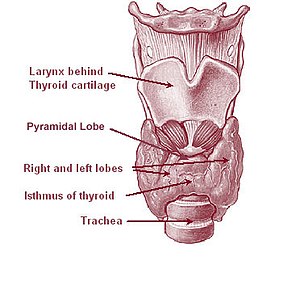Thyrotoxic periodic paralysis
| Thyrotoxic periodic paralysis | |
|---|---|
 |
|
| Thyrotoxic periodic paralysis occurs when the thyroid gland releases excessive amounts of thyroxine (thyroid hormone). | |
| Classification and external resources | |
| Specialty | neurology |
| ICD-10 | G72.3 |
| ICD-9-CM | 359.3 |
| OMIM | 188580 613239 |
| DiseasesDB | 29122 |
| MedlinePlus | 000319 |
| eMedicine | article/1171678 |
| MeSH | D020514 |
| GeneReviews | |
Thyrotoxic periodic paralysis (TPP) is a condition featuring attacks of muscle weakness in the presence of hyperthyroidism (overactivity of the thyroid gland). Hypokalemia (a decreased potassium level in the blood) is usually present during attacks. The condition may be life-threatening if weakness of the breathing muscles leads to respiratory failure, or if the low potassium levels lead to cardiac arrhythmias (irregularities in the heart rate). If untreated, it is typically recurrent in nature.
The condition has been linked with genetic mutations in genes that code for certain ion channels that transport electrolytes (sodium and potassium) across cell membranes. The main ones are the L-type calcium channel α1-subunit and potassium inward rectifier 2.6; it is therefore classified as a channelopathy. The abnormality in the channel is thought to lead to shifts of potassium into cells, under conditions of high thyroxine (thyroid hormone) levels, usually with an additional precipitant.
Treatment of the hypokalemia, followed by correction of the hyperthyroidism, leads to complete resolution of the attacks. It occurs predominantly in males of Chinese, Japanese, Vietnamese, Filipino, and Korean descent. TPP is one of several conditions that can cause periodic paralysis.
An attack often begins with muscle pain, cramping, and stiffness. This is followed by weakness or paralysis that tends to develop rapidly, usually in late evening or the early hours of the morning. The weakness is usually symmetrical; the limb muscles closer to the trunk (proximal) are predominantly affected, and weakness tends to start in the legs and spread to the arms. Muscles of the mouth and throat, eyes, and breathing are usually not affected, but occasionally weakness of the respiratory muscles can cause life-threatening respiratory failure. Attacks typically resolve within several hours to several days, even in the absence of treatment. On neurological examination during an attack, flaccid weakness of the limbs is noted; reflexes are usually diminished, but the sensory system is unaffected. Mental status is not affected.
...
Wikipedia
